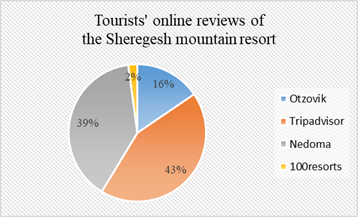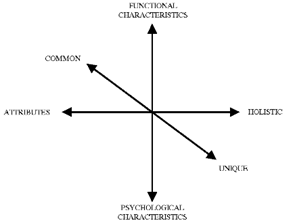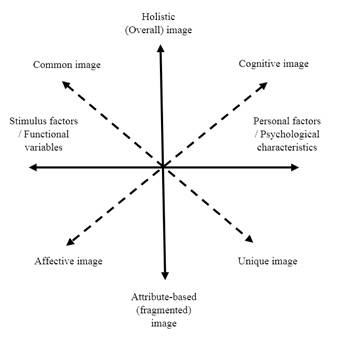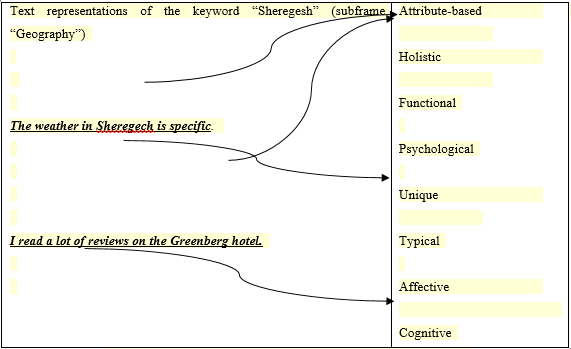Abstract
The universally acknowledged importance of tourist destination image has led to a substantial body of research on the topic. This paper focuses on examining the key factors of destination image formation in tourists’ online reviews. The study offers an integrated approach drawing on the image branding research findings and the linguocognitive methodology of the regional image formation. The authors establish the systemic correlation between the standardized set of destination image components developed in tourism studies and the cognitive categories described by applying the linguistic methods of conceptual analysis, such as key words, slots and sub-frames. The study analyses electronic word-of-mouth in the context of actualizing the destination image components, which are seen to be salient in the process of destination image formation, in online travel reviews. The qualitative techniques of textual analysis have been combined with the elements of content analysis in order to examine how the destination variables contribute to the mountain resort image formation. As the findings show, attribute-based and functional variables as well as the strategies of affective image building play more essential role in constructing online image of the Siberian mountain resort Sheregesh (Kemerovo Oblast, Russia) than it was hypothesized. The research has practical value as it contributes to the mountain resort image development. It also expands the studies of E-WOM (electronic word-of-mouth) communication, which has been engaging a dramatically growing number of participants in recent years. The findings also provide useful insights for Siberian territories research from the perspectives of linguistics and management.
Keywords: Sheregeshtourists’ reviewssub-framescontent analysis
Introduction
With the advent of the Web 2.0 technologies, tourists’ impressions and word-of-mouth (WOM) information about a place began to be communicated online (Ban, 2016; Litvin, Goldsmith, & Pan, 2008). Tourism entered the new epoch of the electronic travel. Even remote places, which previously saw no massive consumption, are becoming electronically available as increasingly covered on travel-blogs, online forums, in tourists’ online reviews (Banyai & Glover, 2012; Nedelea, 2016; Pan, MacLaurin, & Crotts, 2007).
Problem Statement
Given high degree of distribution tourist information becomes digital and the large-scale, anonymous, ephemeral nature of the Internet induces new ways of capturing, analyzing, interpreting, and managing online WOM. Litvin et al., (2008) clearly define a new form of tourism product information exchange spread through electronic means. Among the key characteristics of WOM the researchers mention the perceived independence of the source of the message, remarking that “with information technology today ubiquitous, that WOM is becoming both more pervasive and amorphous” (Litvin et al., 2008, p. 461).
Research Questions
Accordingly, the researchers conceptualize the construct of tourist online destination image (TODI) (Hunter, 2016; Mak, 2017; Schwaighofer, 2014). While Hunter (2016) argues that online image is a social-semiotic construction rather than the marketers' projected image, other researchers outline that the online representation of a destination’s image can be defined as the online representation of the collective beliefs, knowledge, ideas, feelings and overall impressions of a destination (Gartner, 1993; Jeacle & Carter, 2011; Mak, 2017). Supporting the arguments of Oliveira and Panyik (2015), Ban (2016) notes, “in a new digital era a simple tourist or traveler is an active creator of a destination brand” (p. 15).
Purpose of the Study
Nowadays, tourist websites are considered to become “the main tool for consumers to organize their holidays themselves by taking advantage of pre-trip searching and post-trip evaluating the destination according to personal desires and experiences” (Held, 2018, p. 211).
Research Methods
Some platforms including Tripadvisor are highly relevant to the investigation into using social media to understand personal experiences of climate by tourists. This has become one of the reasons why reviews posted in a personal capacity have been suggested to hold greater value, trust and reliability than reflections collected by research professionals (Jeacle & Carter, 2011). Indeed, prospective visitors of a place prefer to form their opinions much depending on other citizens’ reviews, their imagery and critics shared online. The combination of credibility and accessibility renders TGC a powerful medium in shaping the online image of a destination (Banyai & Glover, 2012; Pan et al., 2007; Mak, 2017).
Findings
While destination image studies are extensively covered in scientific literature on tourism management, application of linguistic analysis to the domain of the online image of a territory is under-represented. In discourse studies, latest attention is given to the analysis of tourism discourse in general, but the online destination image forming factors that have discursive nature relatively lack serious understanding (Figueiredo & Pasquetti, 2016; Gretzel & De Ascaniis, 2013; Held, 2018; Nedelea, 2016; Pagano, 2014). Besides, most existing studies have explored the online destination image through NTO-generated contents (National Tourism Organizations), leaving a gap in understanding the online destination image manifested in the tourist generated content (Mak, 2017).




Conclusion
Destination Image studies in Marketing and Tourism
The studies investigating the formation of Tourist Destination Image (TDI) promoted by Websites as well as printed advertising sources have been of great importance recently. In the earliest studies of TDI scholars identified three major segments in the formation of the concept of image: the organic, the induced and the modified induced image (Dann, 1996). The development of these ideas has led to an understanding of TDI as necessarily divided into primary and secondary images. The information acquired through personal experience or visitation of the destination contributes to the formation of primary image. In contrast, secondary image is formed by organic, induced and autonomous information sources, to which the consumer is exposed (Beerli & Martin, 2004). Together with these observations, it was found that destination image is shaped by the images that are evoked by a place, and by the atmosphere and the attractions that the consumer expects from it (Etchner & Ritchie, 2003).
Importantly, tourist destination image is mostly seen as a “set of expectations and perceptions a prospective traveller has of a destination” (Gallarza, Gil, & Calderón, 2002, p. 17). The researchers discuss the dynamic nature of the concept, arguing that TDI refers to perceptions of tourists at a destination, corresponding to the perceived contribution of various services to be found there, such as for example accommodation, food or transport. Baloglu and McCleary (1999) proposed a model which takes into consideration: a) stimulus factors (functional variables, which can be directly observed and /or measured); b) personal factors, (psychological characteristics not directly observable). Additionally, the bipartite nature of the phenomenon presupposes that image is shaped by the consumers’ reasoned as well as emotional interpretation (Baloglu & McCleary, 1999). To sum up, destinations are perceived in the form of stereotypes, which exist in human minds and form “tourists’ mental constructs” (Pagano, 2014).
A conceptualization of image encompassing all of these components is provided by Etchner and Ritchie (2003), who found that destination image research can be seen as a subset of the broader field of imagery research, which principally belongs to the field of psychology. In this perspective, a destination image should be perceived in terms of both individual attributes (e.g. climate, accommodation facilities) and holistic impressions (e.g. mental pictures or imagery of a destination) (Etchner & Ritchie, 2003). The scholars draw a model of TDI based on the standardized set of components: attribute-based vs holistic image, functional vs psychological image, typical vs unique image (Figure
According to the proposed model, the image of a travel destination (Figure
In the 2017 study, Mak (2017) gives an overview of the previous image types, indicating that the final continuum, common-unique, highlights that DI can range from those perceptions based on common characteristics to those based on unique features or auras (Figure
Gartner (1993) further distinguishes three interrelated components: cognitive, affective and conative, assuming that cognitive component is an antecedent of the affective component, and the combination of these two components leads to an overall image of a destination (Mak, 2017). Furthermore, the measurement of destination image should reflect both cognitive and affective aspects (Byon & Zhang, 2010; Gartner, 1993; Mak, 2017).
In general, destination image is seen as an important component of tourism discourse marked with its intangible and heterogeneous nature (Holloway, 2004). However, the research line is characterised by its integrative nature, meaning that there are many different approaches to studying destination image (Gallarza et al., 2002).
Linguistic insights into the Destination Image
Texts are essential parts of most social events (Figueiredo & Pasquetti, 2016). However, for a few decades, destination image has been one of the dominant areas of tourism research (Hosany, Ekinci, & Uysal, 2006). Until mid-nineties little has been done to settle a dialogue between scholars who primarily study discourse (language in particular) and communication, and those whose primary focus is tourism (Jaworski & Pritchard, 2005). As tourism discourse is an area of intense semiotic and symbolic production, discourse and communication are considered to be vital prisms through which we can examine tourism (Scollon & Scollon, 2003). Therefore, interrelationship between tourism, discourse and communication offers a useful transdisciplinary techniques that help to explore the possibilities, tensions, conflicts and representations (Figure
According to Dann (1996), tourist communication nonetheless is supposed to constitute a discourse of its own. Urry 1990 introduces the concept of “the tourist gaze” conceiving tourism as a bundle of discursively skilled practices of vision. In Held’s (2018) view, the focus has to be put on the various ways of language performance and how they are evidenced in tourist discourse.
Siberia’s Image studies in cognitive science
The concept of an image is seen as a mental construct and should be analysed within the methodology of cognitive sciences (Bolshakova, 2016; Sushnenkova, 2011). As far as Siberia territory image studies are concerned, much has been done in terms of language and cognition based research, namely the insight into the phenomenon of stereotyping in image formation (Bolshakova, 2016; Kondrat’eva, 2018; Orlova & Ivanova, 2014; Sushnenkova, 2011; Terskikh & Malenova, 2015a, 2015b). In the works, Terskikh and Malenova (2015a; 2015b) attempted to reconstruct the image of Siberia within the framework of cognitive analysis. The authors assumed that over a long time, the perceived image of Siberia was shaped by negative, ironic attitudes and descriptions captured at the times of Stalin’s Russia. By applying language-based approach to the study of regional image-making the authors argue that current perceived image of Siberia needs urgent reframing and more global dissemination (Terskikh & Malenova, 2015a; 2015b).
Acknowledgments
The research was supported by the Russian Foundation for Basic Research and the government of Kemerovo region, Russian Federation. Project No. 18-412-420003 r_а "Kuzbass: Complex cognitive-discursive study of the regional image".
References
- Baloglu, S., & McCleary, K. (1999). A Model of Destination Image Formation. Annals of Tourism Research, 26(4), 868–897.
- Ban, O. I. (2016). The Role of Destination Attributes in Assessing. Constructing the Image of Tourist Destination. In Strategic Tools and Methods for Promoting Hospitality and Tourism Services (pp. 1–25). IGI Global.
- Banyai, M., & Glover, T. D. (2012). Evaluating Research Methods on Travel Blogs. Journal of Travel Research, 51(3), 267–277.
- Beerli, A., & Martin, J. D. (2004). Factors Influencing Destination Image. Annals of Tourism Research, 31, 657–681.
- Bolshakova, L. P. (2016). Conceptualization of the Image of Siberia in Contemporary Travel Literature. Journal of Siberian Federal University. Humanities & Social Sciences, 3(9), 551–558.
- Byon, K. K., & Zhang, J. J. (2010). Development of a scale measuring destination image. Marketing Intelligence & Planning, 28(4), 508–532.
- Dann, G. M. S. (1996). The Language of Tourism: a Sociolinguistic Perspective. Wallingford.
- Etchner, C. M., & Ritchie, J. R. B. (2003). The meaning and measurement of destination image. The Journal of Tourism Studies, 14(1), 37–48.
- Figueiredo, D. C., & Pasquetti, C. A. (2016). The discourse of tourism: an analysis of the online article "Best in Travel 2015: Top 10 cities" in its translation to Brazilian Portuguese. Ilha do Desterro, 69(1), 201–212.
- Gallarza, G. M, Gil, I. C., & Calderón, H. C. (2002). Measuring destination image an approach by an attribute‐based analysis. Tourism Review, 56(1/2), 13–22. DOI:
- Gartner, W.C. (1993). Image Formation Process. Journal of Travel and Tourism Marketing, 2(2/3), 19–216.
- Gretzel, U., & De Ascaniis, S. (2013). Communicative functions of Online Travel Review titles. A pragmatic and linguistic investigation of destination and attraction titles. Studies in Communication Sciences, 13, 156–165.
- Held, G. (2018). Strategies of adaptation in tourist communication: Linguistic Insights. BRILL.
- Holloway, J. C. (2004). Marketing for Tourism. Harlow, Essex: Pearson Education Ltd.
- Hosany, S., Ekinci, Y., & Uysal, M. (2006). Destination image and destination personality: An application of branding theories to tourism places. Journal of Business Research, 59(5), 638–642.
- Hunter, W.C. (2016). The social construction of tourism online destination image: A comparative semiotic analysis of the visual representation of Seoul. Tourism Management, 54, 221–229.
- Jaworski, A., & Pritchard, A. (2005). Discourse, Communication and Tourism. Buffalo; Toronto, Channel View Publications.
- Jeacle, I., & Carter, C. (2011). In TripAdvisor we trust: Rankings, calculative regimes and abstract systems. Accounting, Organizations and Society, Elsevier, 36(4), 293–309.
- Kondrat'eva, O. N. (2018). Applying psycholinguistic approach to the regional image reconstruction (a case study of Kuzbass. In Psiholіngvіstika v suchasnomu svіtі – 2018. Abstracts of XІІІ International Scientific Conference, Pereyaslav-Khmelnitski, Ukraine (pp. 126–129).
- Litvin, S. W., Goldsmith, R. E., & Pan, B. (2008). Electronic word-of-mouth in hospitality and tourism management. Tourism Management, 29(3), 458–468.
- Mak, A. H. N. (2017). Online Destination Image: Comparing National Tourism Organisation’s and Tourists’ Perspectives. Tourism Management, 60, 280–297.
- Nedelea, A. -M. (2016). Strategic Tools and Methods for Promoting Hospitality and Tourism Services. IGI Global.
- Oliveira, E., & Panyik, E. (2015). Content, context and co-creation: Digital challenges in destination branding with references to Portugal as a tourist destination. Journal of Vacation Marketing, 21(1), 53–74.
- Orlova, V. V., & Ivanova, E. S. (2014). Mental representations of Tomsk (case study of university students) Saint Petersburg University Bulletin, 12, 1. Retrieved from: https://cyberleninka.ru/ article/n/mentalnye-obrazy-goroda-tomska-na-primere-studentov-universiteta
- Pagano, N. (2014). Tourism Destination Image and Irish Websites. International Journal of Business and Social Science, 5, 8(1), 178–188.
- Pan, B., MacLaurin, T., & Crotts, J. C. (2007). Travel Blogs and the Implications for Destination Marketing. Journal of Travel Research, 46(1), 35–45. https://dx.doi.org/10.1177/0047287507302378
- Schwaighofer, V. (2014). Tourist Destination Images and Local Culture: Using the Example of the United Arab Emirates. Springer Gabler.
- Scollon, R., & Scollon, W. S. (2003). Discourses in Place: Language in the Material World. London: Routledge.
- Sushnenkova, I. A. (2011). Linguocognitive study of regional image (case study of Omsk oblast). Bulletin of Omsk University, 4, 233–237. Retrieved from: https://cyberleninka.ru/article/n/ lingvokognitivnoe-modelirovanie-kak-perspektivnyy-metod-issledovaniya-regionalnogo-imidzha-na-primere-imidzha-omskoy-oblasti
- Terskikh, M., & Malenova, E. (2015a). Metaphorical Conceptualization of the Concept of Siberia in Modern American Mass Media Discourse. Procedia – Social and Behavioral Sciences, 214(5), 1125–1133.
- Terskikh, M. V., & Malenova, E. D. (2015b). Media image of Siberian region: linguo-cognitive modeling. Omsk: LITERA.
- Thurlow, C., Jaworski, A. (2011). Tourism discourse: Languages and banal globalization. Applied Linguistics Review, 2, 285–312. Retrieved from: http://hdl.handle.net/10722/202407
- Urry, J. (1990). The tourist gaze: Leisure and travel in contemporary societies. London: Sage Publications.
Copyright information

This work is licensed under a Creative Commons Attribution-NonCommercial-NoDerivatives 4.0 International License.
About this article
Publication Date
28 December 2019
Article Doi
eBook ISBN
978-1-80296-075-4
Publisher
Future Academy
Volume
76
Print ISBN (optional)
-
Edition Number
1st Edition
Pages
1-3763
Subjects
Sociolinguistics, linguistics, semantics, discourse analysis, science, technology, society
Cite this article as:
Saveleva*, I., Kondratieva, O., & Melnik, N. (2019). Siberias Sheregesh: Mountain Resort Image In Online Travel Reviews. In D. Karim-Sultanovich Bataev, S. Aidievich Gapurov, A. Dogievich Osmaev, V. Khumaidovich Akaev, L. Musaevna Idigova, M. Rukmanovich Ovhadov, A. Ruslanovich Salgiriev, & M. Muslamovna Betilmerzaeva (Eds.), Social and Cultural Transformations in the Context of Modern Globalism, vol 76. European Proceedings of Social and Behavioural Sciences (pp. 2797-2805). Future Academy. https://doi.org/10.15405/epsbs.2019.12.04.376
